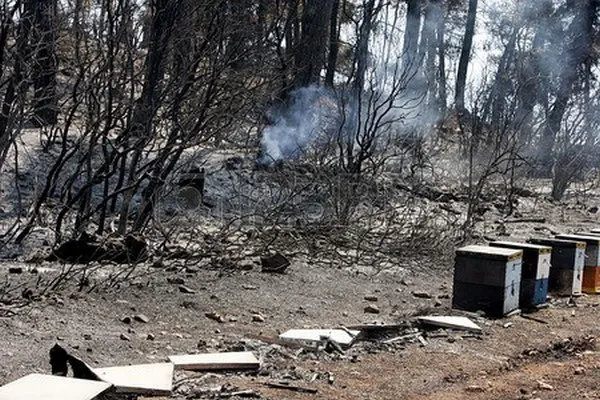As the bushfire crisis across Australia continues, so too does the threat to wildlife including bees which are crucial for successful pollination.
Early assessment has indicated that more than 10,000 honey bee hives have been destroyed across the Australian mainland and around 800 hives and 115 nucleus hives of the unique Ligurian subspecies of honey bee on Kangaroo Island.
The island is renowned for its floral diversity and distinctive tasting honey, being home to the only population of Ligurian bees in the world free of major diseases and biosecurity threats.

Managed European Honey Beehives devastated by bush fires
Hort Innovation Research and Development Manager for Pollination, Ashley Zamek, said the RDC was working with several research institutions across the country to assess the viability of alternative or complementary insect pollinators to ease the pressure on honey bees and their keepers.
“This research is now more important than ever considering the loss of such a significant number of hives during this catastrophic bush fire season,” she said.
Ms Zamek said promising preliminary findings had already been made in areas of alternative pollination where native stingless bees were successfully introduced into protected cropping environments.
She said researchers are also working to diversify landscapes to promote other supporting native insects such as wasps, beetles, birds and the like.
“And in a national first research project, we have partnered with the Department of Primary Industry and Regional Development in Western Australia to trial the use of flies for pollination,” she said.
Professor James Cook from Western Sydney University, who leads several pollination focused projects for Hort Innovation, said these projects are looking to understand what the natural pollinators are doing and how that can be strengthened to better support industry.
“Moving forward we’ll see increasing recognition of the role of wild pollinators and pollinators other than honeybees,” he said.
“What our studies are showing at the moment is that insects such as native bees, wasps, flies and more are already playing quite a big role in pollination, but now we’re starting to get reliable data that demonstrates just what kind of contribution they are making.”
“If you put together all the pollination work we’re doing around the country, what we're looking to do is to be able to provide information for resilient pollination services that don't rely too much on any one situation or one species – leading to a better understanding of all the different options and how we can manage the landscape or the protected cropping environment so that we can harness these natural pollinators and get good pollination for crop production.”
For more information: Hort Innovation
Hort Innovation
horticulture.com.au
